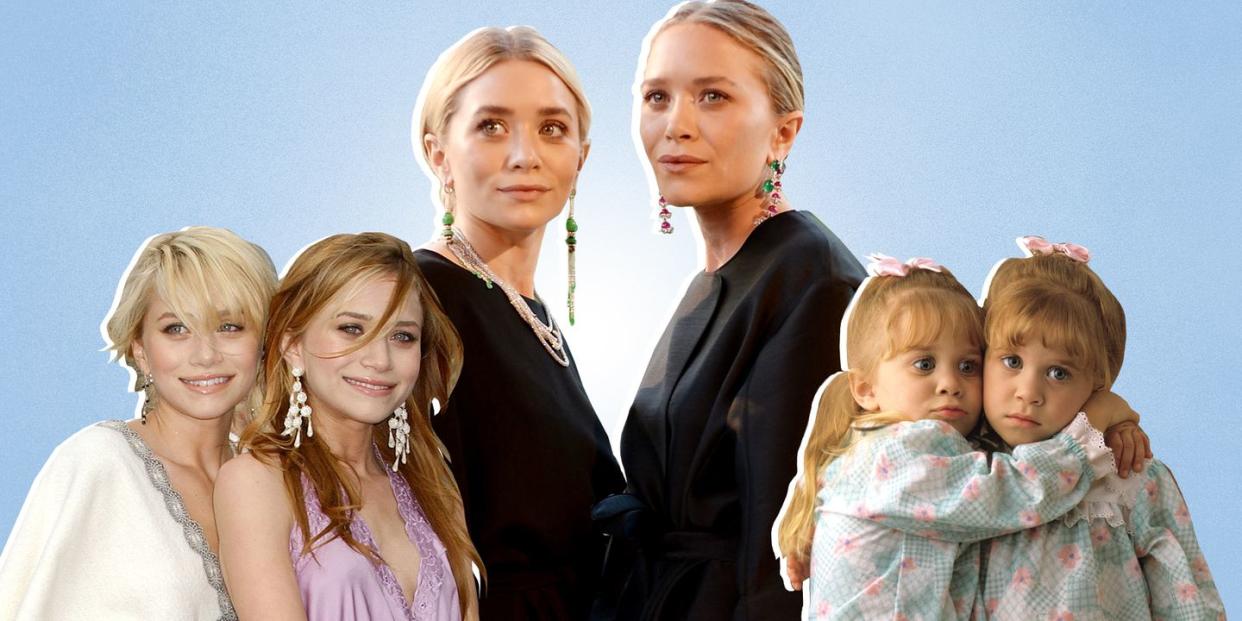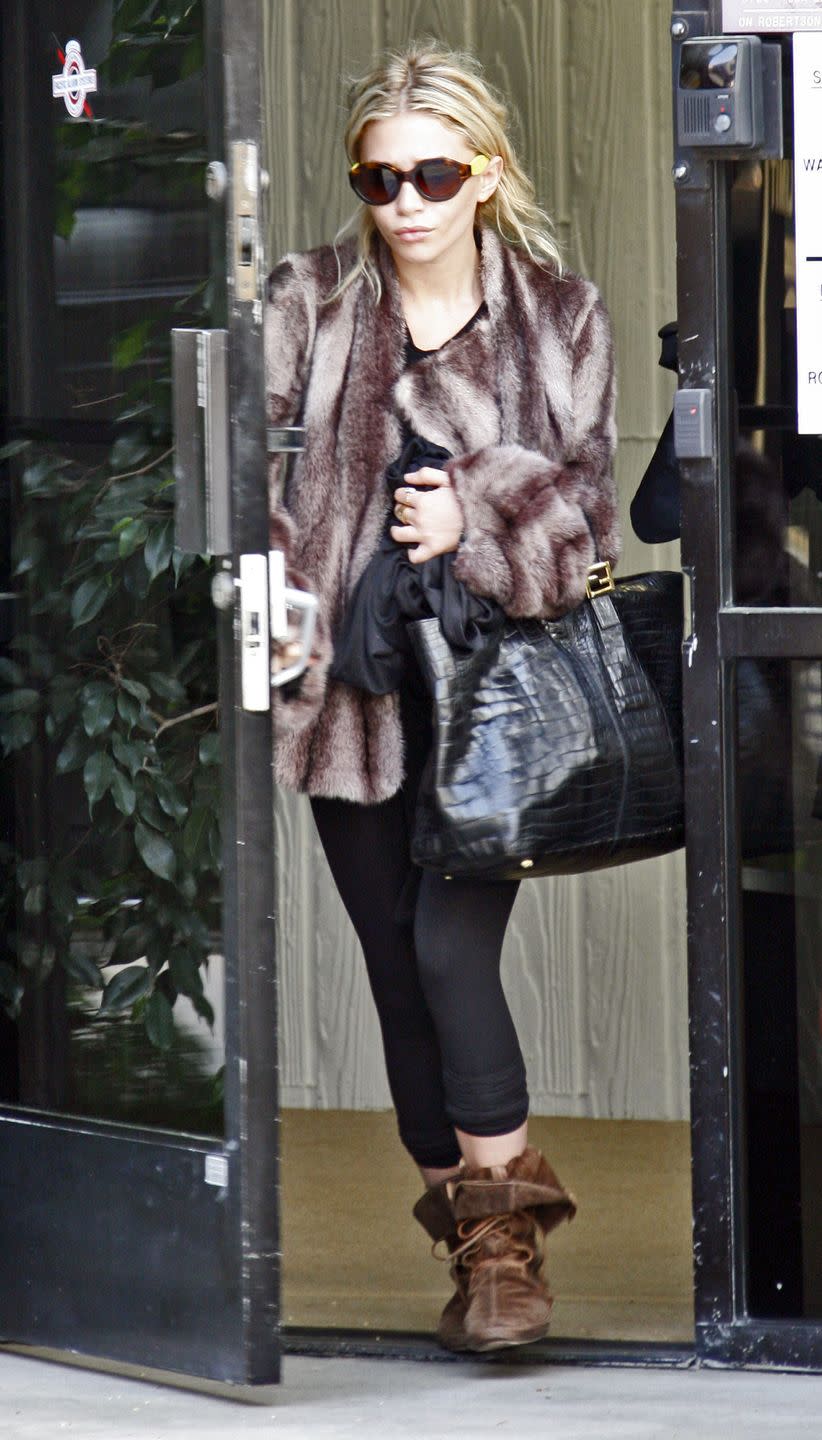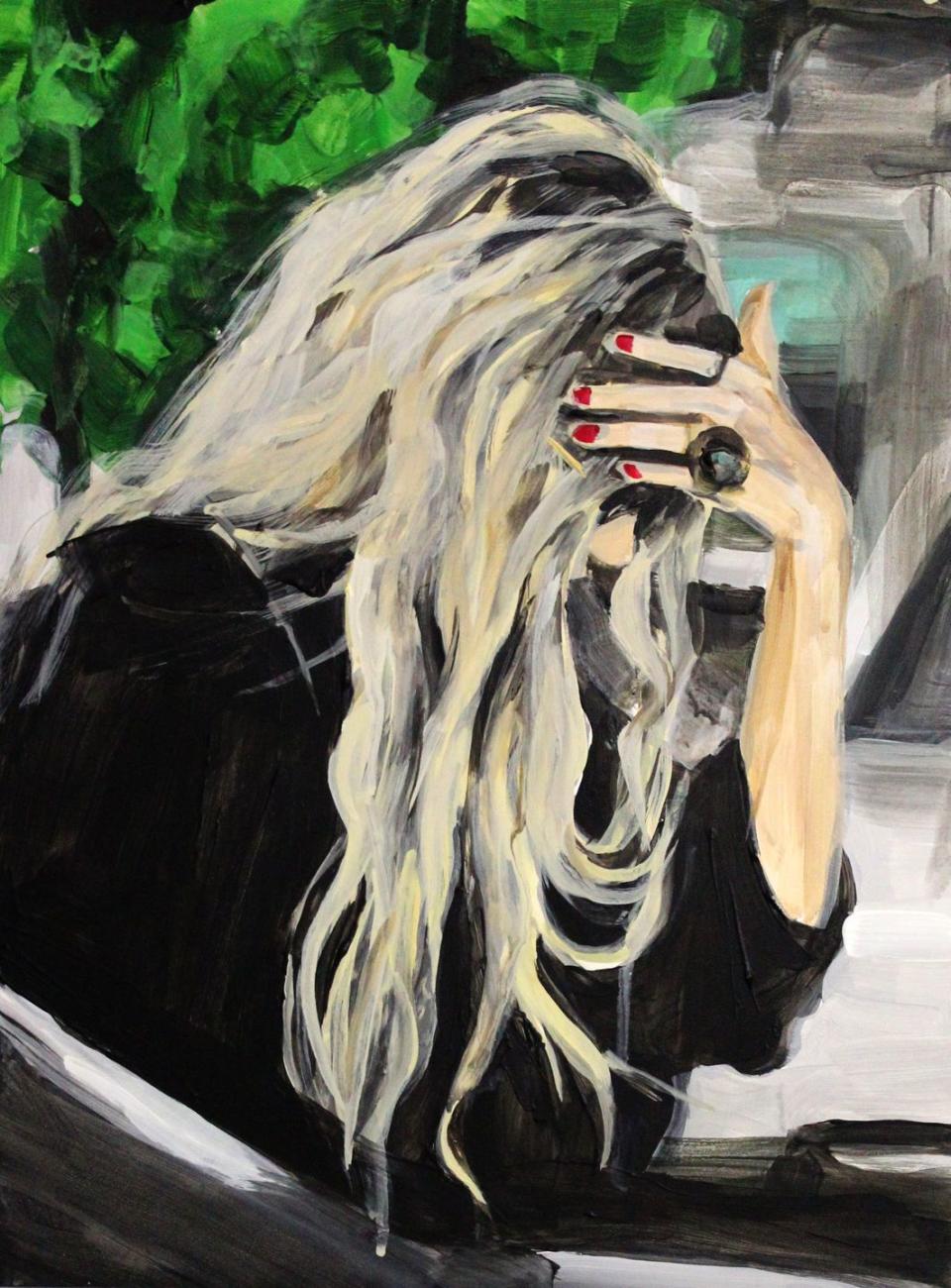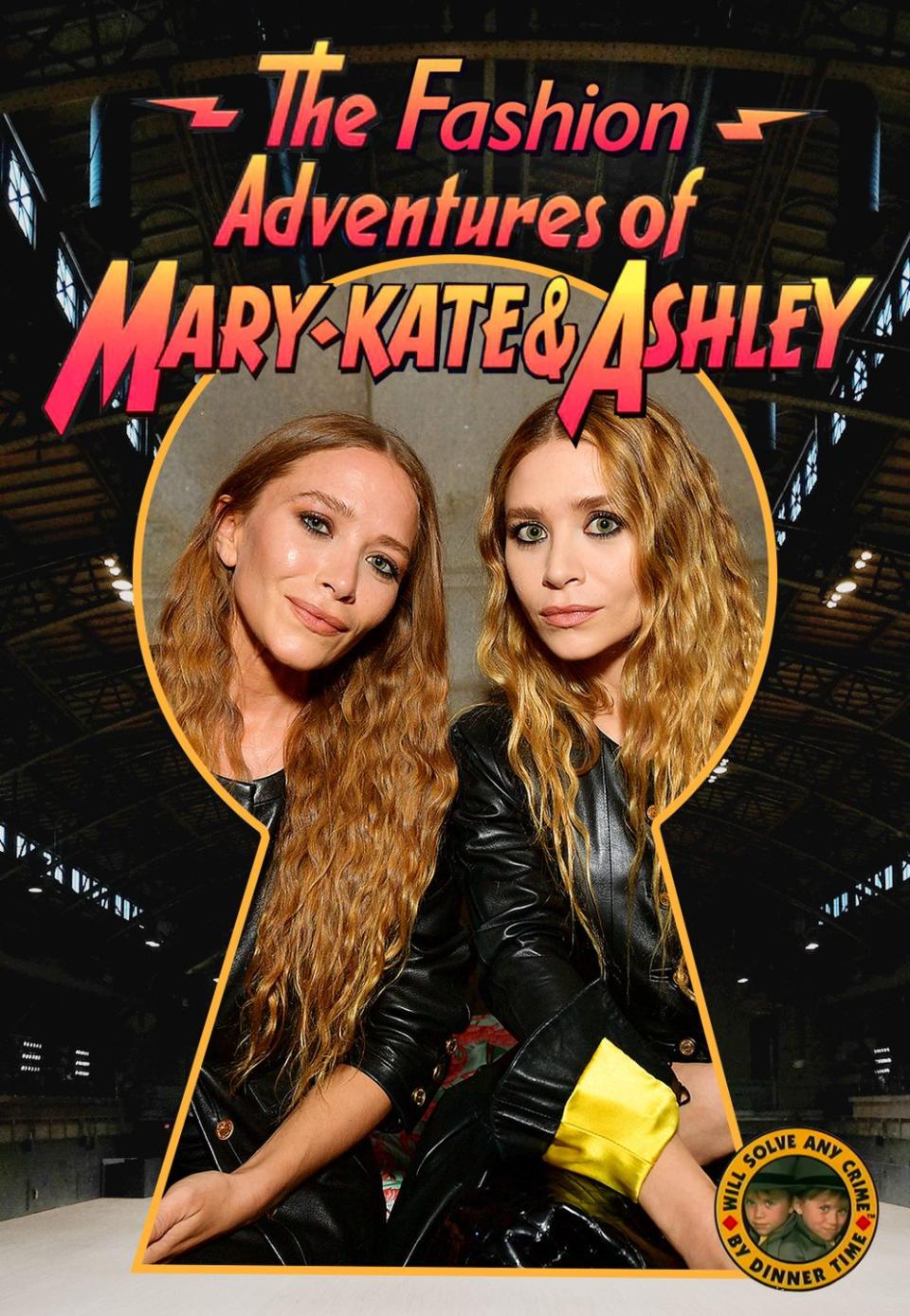How Mary Kate and Ashley Mastered Enigma in the Age of Overexposure

There’s no one like Mary-Kate and Ashley. In all of the extended pop culture pantheon, from minor sorceresses (J. Smith-Cameron, Hunter Schafer) to all-powerful goddesses (Cardi B, Dolly Parton), no celebrities, twins or otherwise, are observed with the same mixture of veneration and bewilderment.
Cigarettes in hand, the Olsens float through our world, abstaining from publicity and social media, offering nothing of themselves to the public—save for a trove of paparazzi photographs, poised to inspire the style and unphased expressions of generations to come. That is, until they do.
Last week, fans were blessed with a rare peek behind the curtain. Five years after the public learned that Mary-Kate had wed Olivier Sarkozy, French financier and half-brother to Nicolas Sarkozy, news broke that she had filed for an emergency divorce petition, claiming that he had terminated the lease on their Gramercy apartment without her consent, and she was in danger of losing her possessions.
This is not, of course, the kind of news fans want from Mary-Kate; it’s objectively sad. But for the most devoted, it’s a gift that there’s Olsen news at all—and, true to form, this revelation was at least a little bizarre. Buried in these court documents are delicious tidbits (they own a second New York apartment on East 49th Street of all places?!), all devoid of context.
It’s the textual equivalent of one of their transcendent paparazzi shots (like, yes, the one with the petite Mary-Kate enjoying a stroll alongside the towering Sarkozy and his child, who is also taller than Mary-Kate).
That all of this would happen during quarantine, when fans would expect to hear even less from the Olsen camp, is wondrous. But even more extraordinary? That the bombshell story doesn’t have a chance of diminishing fans’ love for the twins. For most celebrities, tabloid drama of this caliber would at least threaten to alter their elevated status, but Mary-Kate and Ashley’s pedestal doesn’t even have a crack.
Their impervious platform took a long time to build—and it wasn’t always theirs to shape. Mary-Kate and Ashley’s careers began when they were quite literally babies, too young to comprehend what it meant to star on Full House, let alone consent to it. Once they graduated from their sitcom days, it was on to bonafide child stardom, which required even more exposure. Under the umbrella of their aptly named company, Dualstar, they became the patron saints of ’90s teenyboppers everywhere.
The entrepreneurial twins sold everything from clothes to books to now-classic direct-to-video movies. To grow up in that era was to see them everywhere, and with every sighting, to become more entranced by the power of their choppy, highlighted hair and spaghetti-strap tops.

Hallie Gould, Byrdie beauty editor and lifetime Olsen devotee, offers a prime example of the worship the tpreteen twins inspired. “I would play games by myself where I pretended that I was them,” she laughs. She’d drag her mom out to buy clothes inspired by their outfits—mostly Mary-Kate’s, but also Ashley’s. “It was like the biggest issue in my brain that I didn’t know if I wanted to be more Mary-Kate or more Ashley.”
So large did Mary-Kate and Ashley loom in the collective imagination of their generation, that Gould and her brother were catfished by someone pretending to be Mary-Kate, a girl presumably exploring the limits of the early web’s anonymity, and maybe even living out her own Olsen fantasy. “She would talk about things about filming different movies and stuff, and I realized later that all of the stories she said were from the bloopers,” Gould recalls, in wonderment that she (and the internet) were ever so young.
Then, a generation watched as the twins reemerged during their glamorous NYU years, swaddled in floor-grazing hemlines and scarves and improbable layers, and promptly convinced America’s teens to start dressing on the scrubby side of bohemian.

“I think they called it dumpster chic,” says Teri Agins, longtime fashion critic and author of Hijacking the Runway: How Celebrities Are Stealing the Spotlight from Fashion Designers. “Everything was oversized and they had the bug-eyed glasses and that bag lady look, and they were always carrying a Starbucks. That was a big deal.”
Turns out they were laying the groundwork for their next act. (Like Pokémon, they thrived from the 90s all the way through to today, and grew more powerful with each evolution.) The Olsens turned their backs on acting—though Mary-Kate would take occasional jobs through 2011—and pivoted from an empire built on their personal brand to a business in which they attempted to almost erase themselves, letting the product speak for itself.
Marie Claire editor-in-chief Aya Kanai witnessed the genesis of the Row at a Nylon cover shoot with 20-year-old Ashley back in 2006. “I remember standing at the rack with her, with her holding these T-shirts,” Kanai says. Ashley went through the design—what must have been some of the first samples for the Row—in minute detail, speaking “about the size of the arm holes, and why is the neck like this, how she picked her fabrics.”
Kanai was impressed with her passion, but couldn’t see what would come of it—no one could. Succeeding—really succeeding, not just selling stuff with a famous name attached—in the fashion industry as a celebrity is almost unheard of. “I would not have imagined on that day in 2006 when we were looking at her T-shirts that she was going to turn that into one of the top brands in the luxury fashion space, and be taken very, very seriously by every single media professional and all of us very snobby, frankly, fashion people,” she says. “But when that was the result, I can’t say I was shocked. She’s clearly a very serious businessperson, and she wasn’t taking what she was doing lightly at all.”
Despite their significant resources, Mary-Kate and Ashley faced a steep uphill battle for acceptance in the fashion world. Agins remembers the industry’s interest piqued at the news of the twins trying their hand at fashion, but even after the Olsens proved they were serious (and talented), there were doubters. At their first show, they sent a limited number of looks down the runway, “and that was enough, because everything was perfect.” Still, “people said, ‘Okay, this is a little fluke. It's a one-off.’”
It was not. Per Agins, Julie Gilhart, then the fashion director at Barney’s, saw the potential—in the Olsens, and in their clothes. “[Gilhart] said, ‘They were so smart… They had really thought this thing through.’” Starting with perfect T-shirts, they’d identified a hole in the market, and tailored their business to match it. Says Agins, “The one thing that is often missing in fashion is luxury basics.”
Extreme luxury, at that; the Row’s price points are astronomical. A T-shirt will run you $320; the brand’s legendary alligator backpack went for $39,000, and still sold out. (Interestingly, their more affordable diffusion line Elizabeth & James has been less fruitful, and recently relegated to an exclusive deal with Kohl’s. It’s the rarified market where they thrive.)
A little over a decade later, the Row is wildly successful, worn by both the industry elite—ask a fashion person to talk about the brand and they adopt a reverential tone—and a dedicated pool of wealthy customers. “It's this little secret that you feel you've unearthed when you start to realize how many powerful, successful, wealthy women are wearing primarily the Row,” says Emma McClendon, Associate Curator of Costume at the Museum at FIT.
When Barney’s filed for bankruptcy, it came out that the retailer owed $3.7 million to the Row, proof, says McClendon, of something she had heard from people who worked in the industry: “The Row was the brand that sold before sale. It's sold at full price and it sold out.”
And somehow, the Olsens cultivated their dedicated clientele without marketing. Famously, the Row doesn’t really advertise, and the Olsens forgo a lot of fashion’s expected glad-handing. Finding success this way is “almost impossible,” says Kanai. “They don’t go to events; they barely stand on a red carpet ever. They’re not social climb-y in any way. They don’t even want to participate.”
It’s brilliant, really. By receding into the background, the Olsens ferried the Row across the celebrity label trap, which would’ve won them disdain from fashion editors, if immediate (but short-lived) retail success. Except, they’re probably not trying to best the industry in three-dimensional chess. “I just don't think that it's a part of a larger strategy,” says WWD style director Alex Badia, who regularly features them in the magazine's annual CFDA issue. “I think that's who they are as people; they are private… I work with so many designers, they tend to be the most reserved.” (For the record, Badia also found them to be “very kind, very polite” and “super-punctual” and “super-professional”—“much more professional than a lot of people I work with.”)
Rather, the reticence is an extension of who they are. It’s there in their runway shows, which are noticeably devoid of any overwrought installations in an era where the all-importance of the “Instagram moment” is taken as gospel. “There are benches, you sit down,” says Kanai of the Row’s take on fashion week. “When you’re there, it doesn’t feel exclusive. Getting to the point where you would be invited to their show is the exclusive part.”
A post shared by The Row (@therow) on Jun 27, 2019 at 6:50am PDT
It’s there in how they move through the world. “They don’t take up a lot of space, literally or figuratively,” agrees Justine Carreon, market editor at ELLE.com, who assisted on a shoot with them a few years back. Still, “you could feel the room really shift when they came in.” Carreon adds, “everyone in the fashion industry has a story of being around them and still being shocked and speechless,” despite spending time with celebrities and designers day-in and day-out.
Even their personal style goes against the grain. Read any “how to dress” article aimed at a petite audience, and it will warn against the menace that is the unstructured garment, the peril of forgoing heels. The Olsens, on the other hand, live in flats and oversized pieces. Kerry Pieri, fashion/features director at BAZAAR.com, marvels at their masterful use of volume and length, which they somehow wear “in a way that makes them look taller. I mean they’ll wear slippers on the red carpet. That’s something that they would never tell under 5’4” to do.”
And it’s how they won the fame game, if they’re even playing it. They do what they want, flatly refuse to participate in the celebrity culture—and because of that, they’ve captured the public’s interest and respect.
Alyce Peeler, the superfan behind Instagram’s influential Olsen Oracle account, describes her online community as “protective” of their Queens. “So many of us have the same story of growing up watching them and then once we all became women, it was nice to see them really succeed and do their own thing with fashion, and just be successful and be really true to who they are,” she says.
More than most, Peeler knows the twins. She aggregates the expected mixture of paparazzi shots, but she also sifts through their friends’ social media clips to find candid photos and clips—a genre of Olsen content that many aren’t even aware exists. “There’s this huge misconception that they don’t smile or laugh, and when people say that I just find it to be so inhumane and ridiculous because what human doesn’t show emotion?”
Thanks to her respectful approach, Peeler’s done the impossible: earned the trust of their inner circle. Peeler will get messages from Mary-Kate and Ashley’s friends, offering small pieces of information, which like any good Olsen fan, she devours. “It’s kind of like little gifts that I get to keep to myself,” she says, noting that even if a source wouldn’t mind a story being shared, she usually won’t pass along the treasured anecdotes.
A post shared by olsen oracle by alyce (@olsenoracle) on Nov 28, 2019 at 9:22am PST
She does offer up one example, though: Brooke Garber Neidich of Sidney Garber Jewelry told Peeler that “Ashley took her earrings directly off her ears to wear them” at the Met Gala. “Like… they just take them directly off your ears because they’re so close with her and have that relationship with her.” (Peeler, like many other people I spoke to, sometimes talks about them as if they are one.)
Then, there are the gems of information that surface in the press once in a blue moon, to be collected and hoarded like the precious jewels they are. A prime example? The cigarette bowls that were reportedly a central element of Mary-Kate’s wedding. After a source told Page Six that the nuptial decor featured “bowls and bowls filled with cigarettes, and everyone smoked the whole night,” the story quickly ascended to the upper pantheon of celebrity gossip.
“Ah! The bowls of cigarettes,” says Gould. “That will enchant me for the rest of my life.”
“So good,” sighs comedian-turned-unconventional gallerist Viviana Rosales Olen. So good, in fact, that Olen and her THNK1994 Museum partner, Matt Harkins, devoted part of their exhibition, “The Olsen Twins Hiding From the Paparazzi,” to recreating it.
“It’s just so interesting and so chic and just bizarre,” agrees Laura Collins, the artist whose series of paintings about, well, the Olsen twins hiding from the paparazzi, inspired Olen and Harkins to put on the show. Collins based her artworks on real photographs, “the ones that are a little bit off, that are maybe not the most flattering, but make me feel that the celebrity is much more human and much more relatable.”
Olen and Harkins hung the series in a hallway of the doctor’s office they rented (with the help of some Kickstarter-raised funds), and they admit the effect of them all together was discomforting. Seeing the Olsens hiding from your gaze over and over, fighting to protect their hard-won privacy, it’s hard not to feel like a creep.

That’s the thing about celebrity culture: it’s inherently exploitative, built around what the public wants (more, always more) with little regard for the wellbeing of those at its center. But Mary-Kate and Ashley refused to accept those terms. To love the Olsens is to treasure their refusal to let you in. A profound empathy for the plight of child stars, coupled with an admiration for their decision to turn their backs on the celebrity hamster wheel, powers our unshakeable obsession. They owe us nothing, and we know it.
For a person, particularly a young woman, raised in the ’90s, nothing could be more inspirational. We watched as so many women were chewed up and tossed aside by the tabloids, and were told it was them who had messed up, not our culture that had rigged the game. But here were two women who made it through the gauntlet.
Perhaps it’s because they weren’t alone. Badia was struck with how in tune they were with one another, even for siblings. “I don't really think that they had to exchange much conversation,” he says. “They are very in sync. And I just think that part of their success is that wonderful relationship that they have... they basically look after each other.” They’d need to.
At around the age of eight, Olen had her one encounter with the Olsens—an experience that would haunt her, and eventually inform the THNK1994 show’s voyeuristic undertones. It was at an appearance, a sort of meet-and-greet, in Las Vegas. “You would go to the theme park, and then you wait in line for three hours, and then you get to the end of the line, and they're just sitting there and they're really tired and sad and bored,” Olen remembers, her sympathy palpable. “And I immediately felt like this wave of shame.”
There they were, our primary school idols, “just baking in the hot sun, like freaks on display. And that's what they did for the first 18 years of their life, nonstop. So it's just so fucking cool that once they turned 18, they just were like, ‘We're going to do whatever the fuck we want.’ And they did. And they did it really well.”

You Might Also Like


